Abstract
Of 167 patients referred to a unit treating severe behaviour disorders after brain injury, 54 showed clinical features closely resembling those of gross hysteria as described by Charcot. Close correlation was found with very diffuse insults (hypoxia and hypoglycaemia), but not with severity of injury or with family or personal history of hysterical or other psychiatric disorder. The findings may have implications for the understanding of the nature of hysteria.
Full text
PDF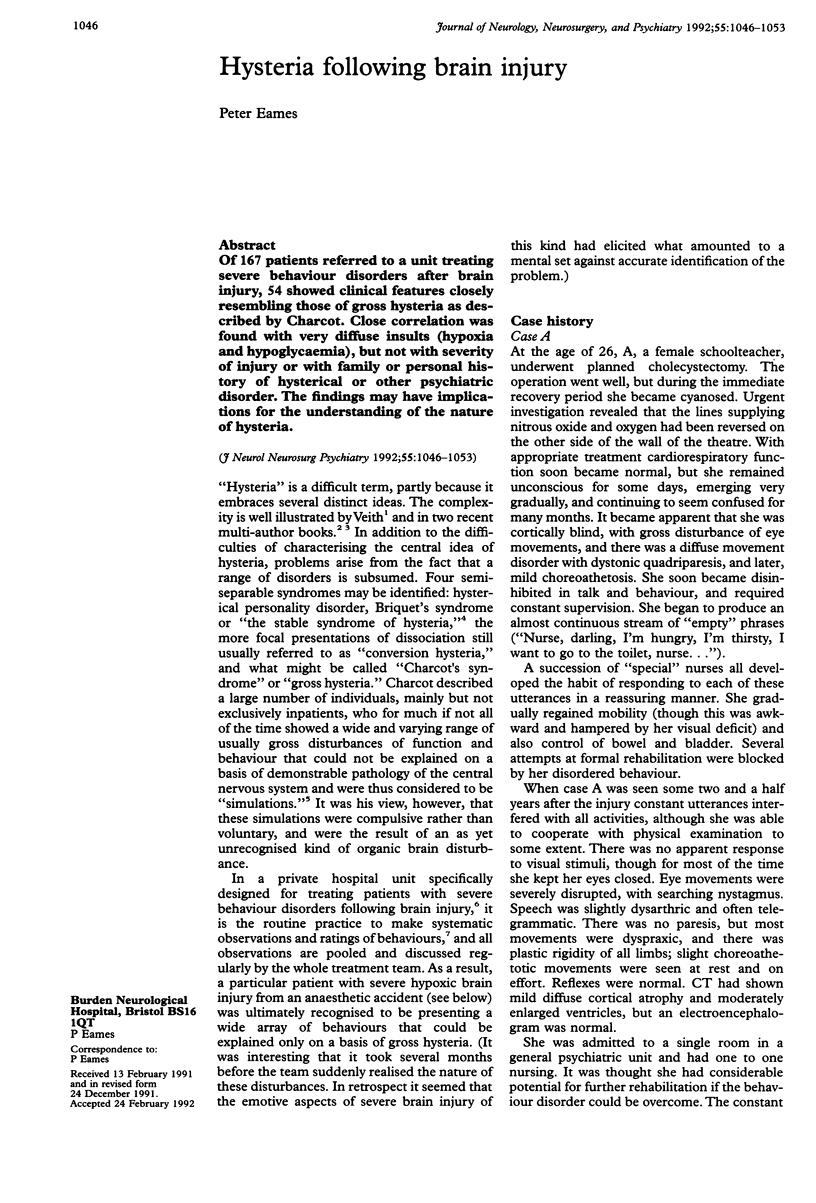
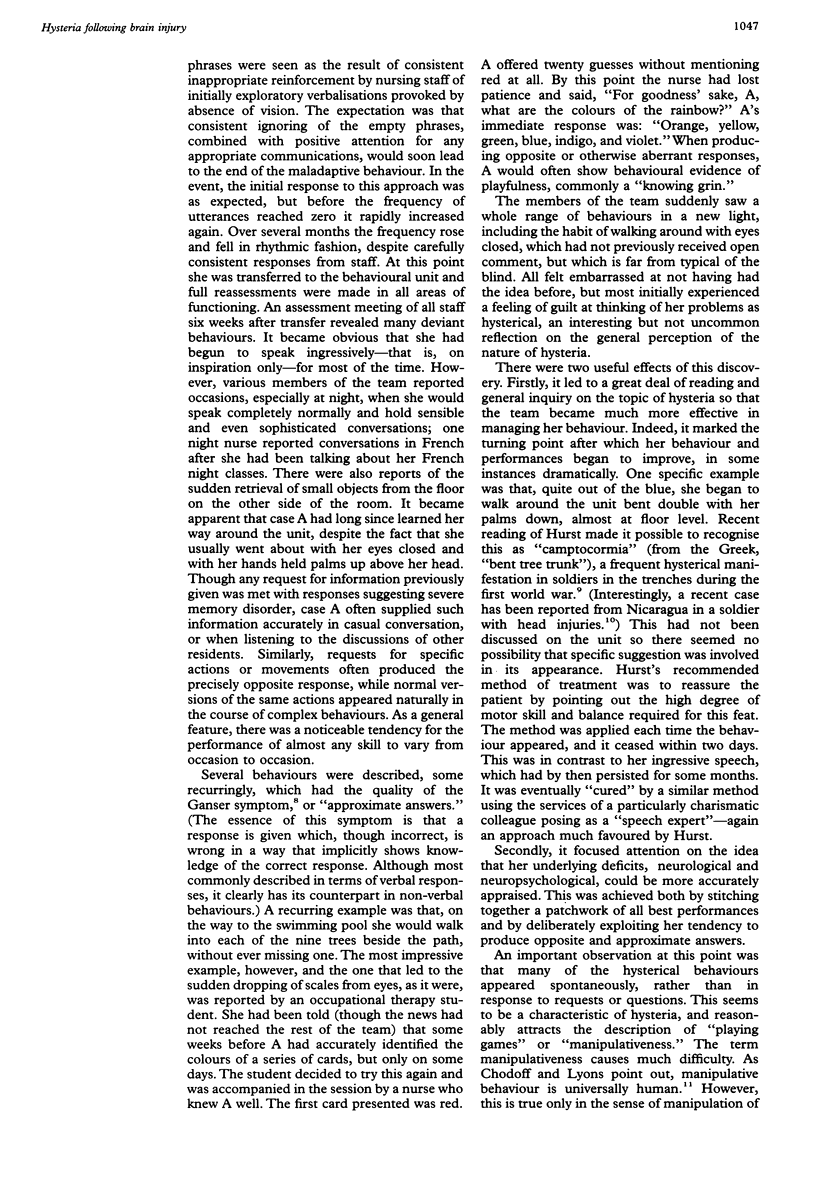
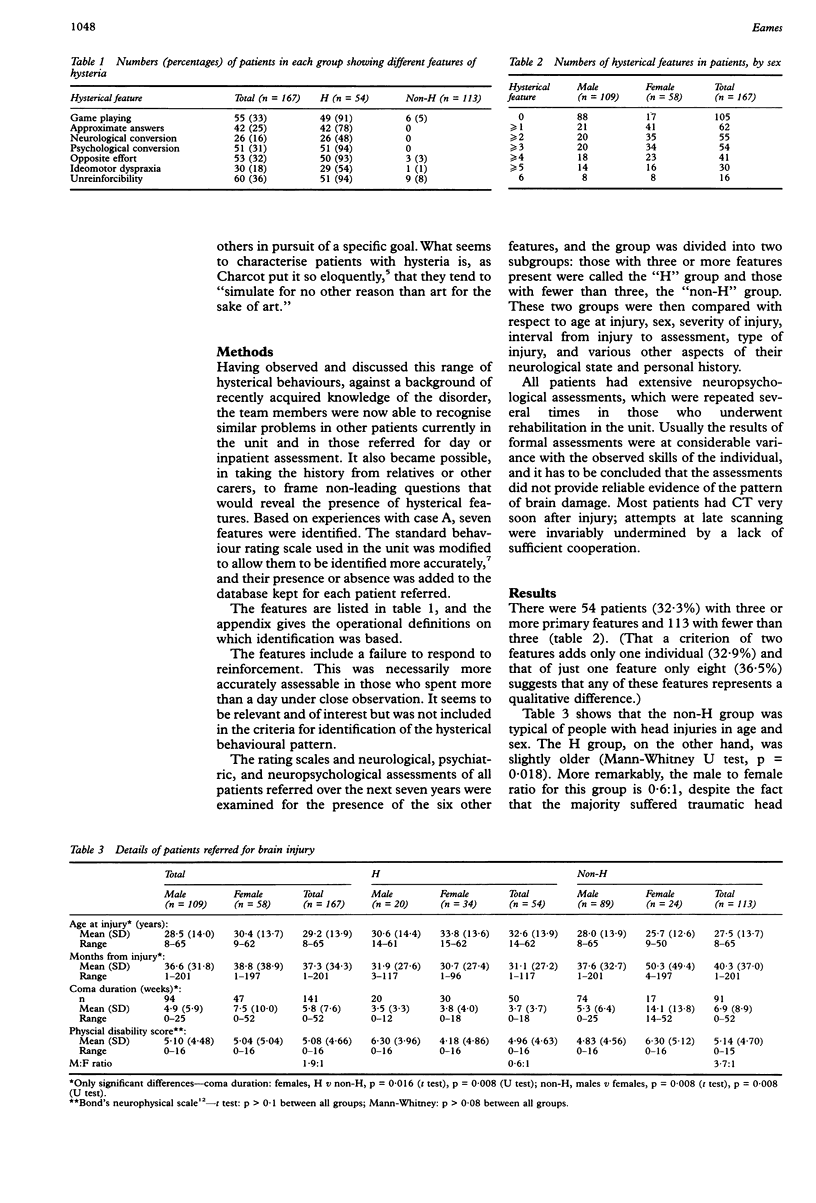
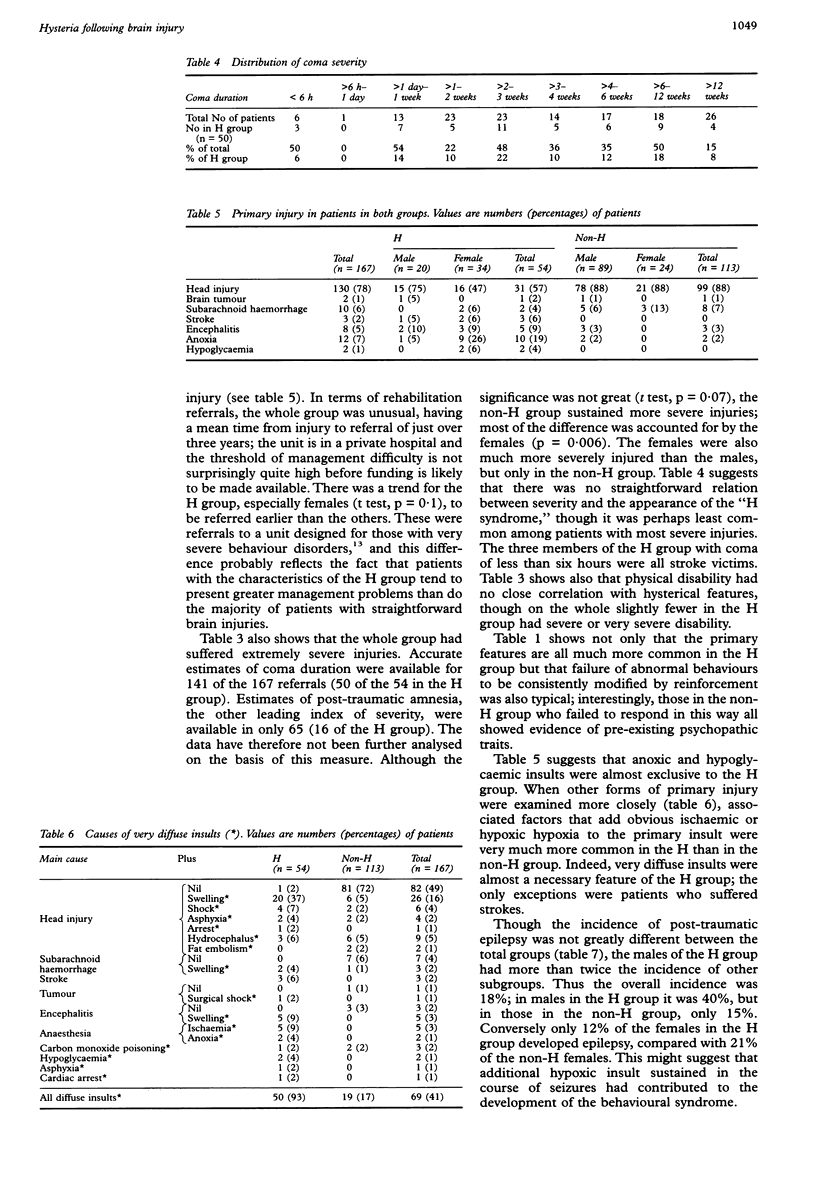
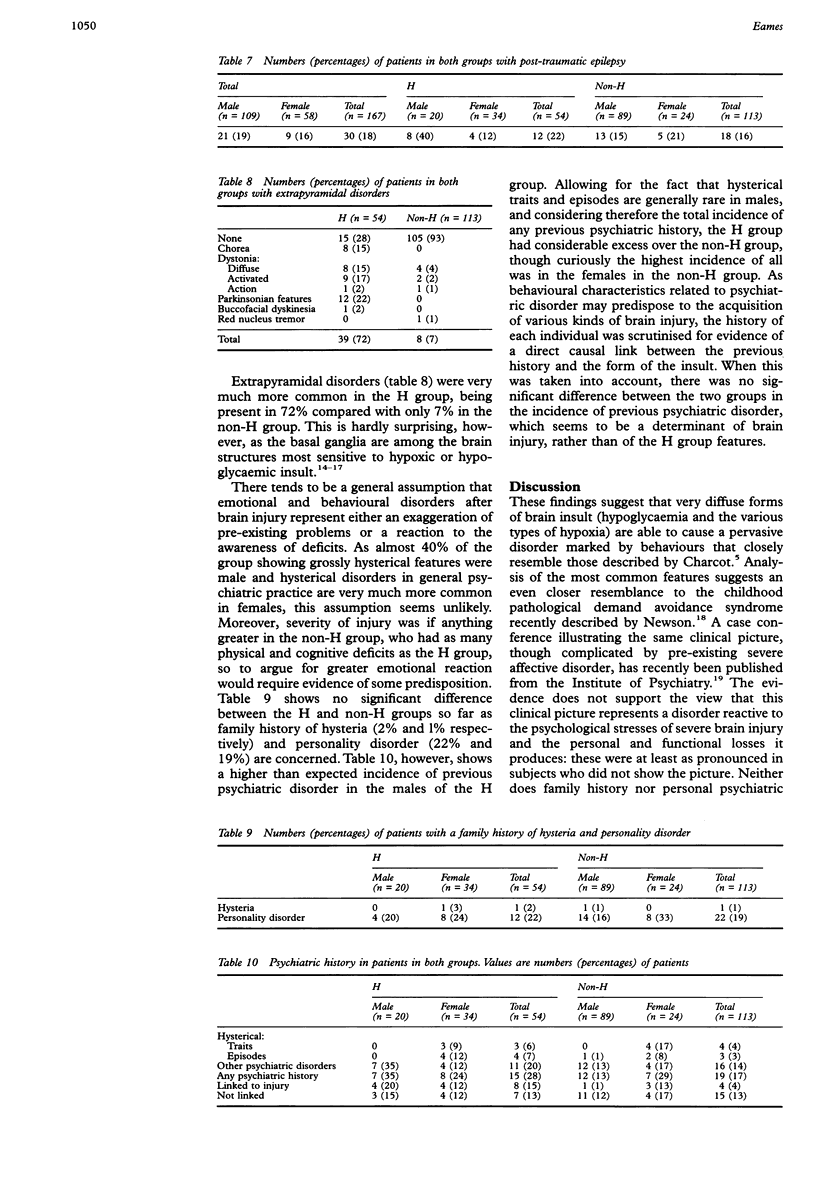
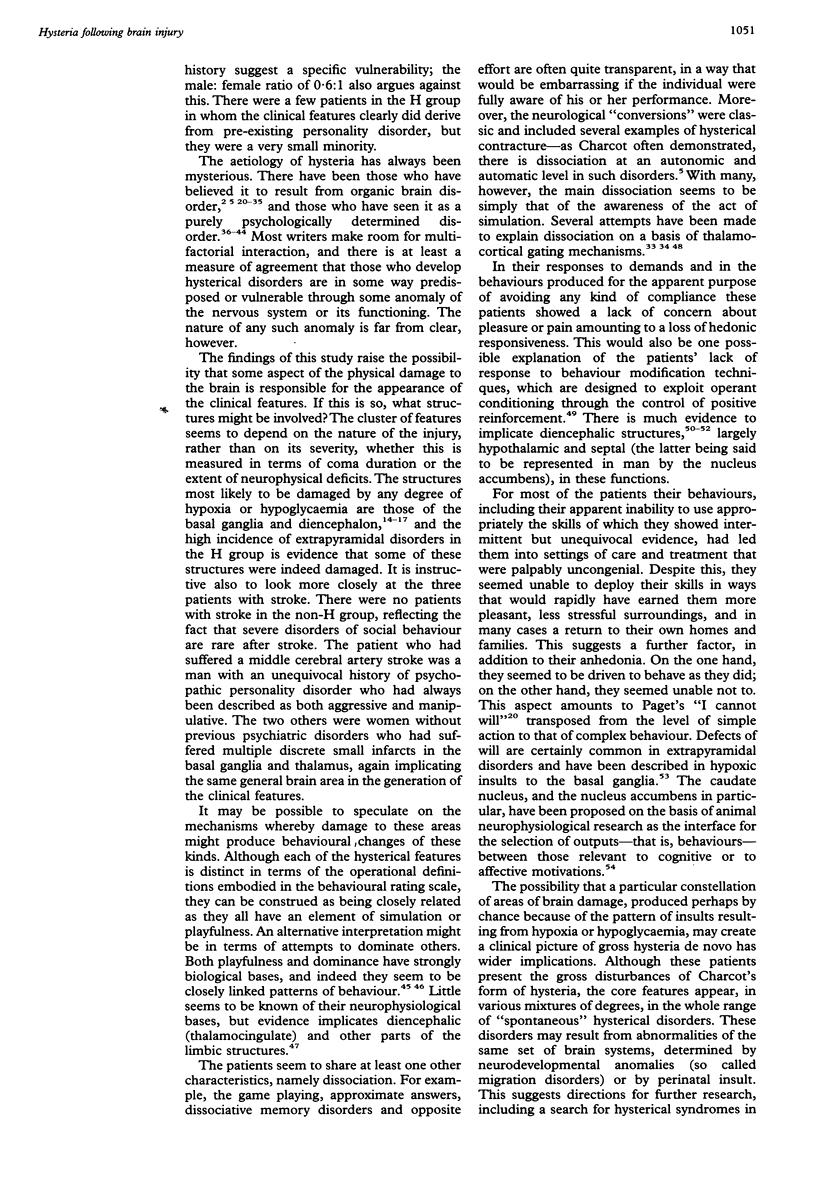
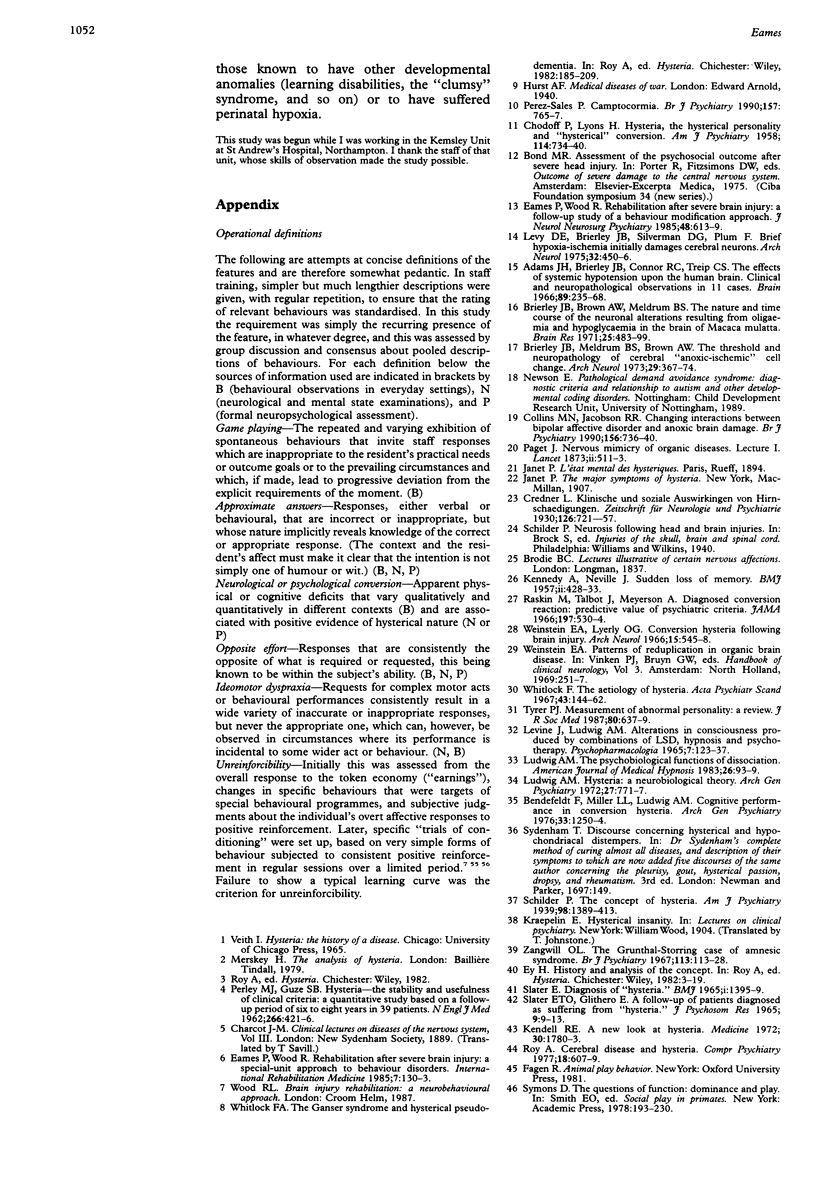
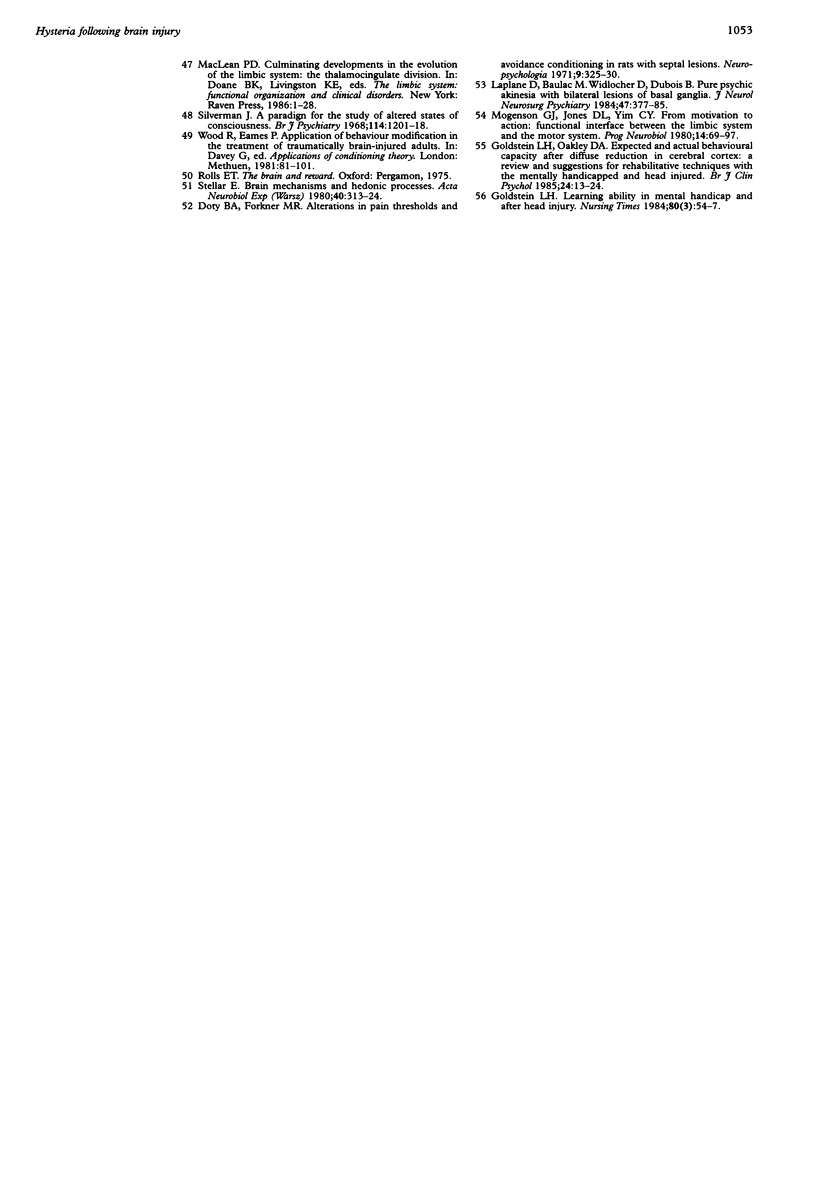
Selected References
These references are in PubMed. This may not be the complete list of references from this article.
- Adams J. H., Brierley J. B., Connor R. C., Treip C. S. The effects of systemic hypotension upon the human brain. Clinical and neuropathological observations in 11 cases. Brain. 1966 Jun;89(2):235–268. doi: 10.1093/brain/89.2.235. [DOI] [PubMed] [Google Scholar]
- Bendefeldt F., Miller L. L., Ludwig A. M. Cognitive performance in conversion hysteria. Arch Gen Psychiatry. 1976 Oct;33(10):1250–1254. doi: 10.1001/archpsyc.1976.01770100112011. [DOI] [PubMed] [Google Scholar]
- Brierley J. B., Brown A. W., Meldrum B. S. The nature and time course of the neuronal alterations resulting from oligaemia and hypoglycaemia in the brain of Macaca mulatta. Brain Res. 1971 Feb 5;25(3):483–499. doi: 10.1016/0006-8993(71)90456-2. [DOI] [PubMed] [Google Scholar]
- Brierley J. B., Meldrum B. S., Brown A. W. The threshold and neuropathology of cerebral "anoxic-ischemic" cell change. Arch Neurol. 1973 Dec;29(6):367–374. doi: 10.1001/archneur.1973.00490300029003. [DOI] [PubMed] [Google Scholar]
- CHODOFF P., LYONS H. Hysteria, the hysterical personality and hysterical conversion. Am J Psychiatry. 1958 Feb;114(8):734–740. doi: 10.1176/ajp.114.8.734. [DOI] [PubMed] [Google Scholar]
- Collins M. N., Jacobson R. R. Changing interactions between bipolar affective disorder and anoxic brain damage. Br J Psychiatry. 1990 May;156:736–740. doi: 10.1192/bjp.156.5.736. [DOI] [PubMed] [Google Scholar]
- Doty B. A., Forkner M. R. Alterations in pain thresholds and avoidance conditioning in rats with septal lesions. Neuropsychologia. 1971 Sep;9(3):325–330. doi: 10.1016/0028-3932(71)90028-5. [DOI] [PubMed] [Google Scholar]
- Eames P., Wood R. Rehabilitation after severe brain injury: a follow-up study of a behaviour modification approach. J Neurol Neurosurg Psychiatry. 1985 Jul;48(7):613–619. doi: 10.1136/jnnp.48.7.613. [DOI] [PMC free article] [PubMed] [Google Scholar]
- Eames P., Wood R. Rehabilitation after severe brain injury: a special-unit approach to behaviour disorders. Int Rehabil Med. 1985;7(3):130–133. doi: 10.3109/03790798509166140. [DOI] [PubMed] [Google Scholar]
- Goldstein L. H. Learning ability in mental handicap and after head injury. Nurs Times. 1984 Jan 18;80(3):54–57. [PubMed] [Google Scholar]
- Goldstein L. H., Oakley D. A. Expected and actual behavioural capacity after diffuse reduction in cerebral cortex: a review and suggestions for rehabilitative techniques with the mentally handicapped and head injured. Br J Clin Psychol. 1985 Feb;24(Pt 1):13–24. doi: 10.1111/j.2044-8260.1985.tb01309.x. [DOI] [PubMed] [Google Scholar]
- Hell D., Six P. Thiamin-, Riboflavin- und Pyridoxin-Versorgung bei chronischem Alkoholismus. Dtsch Med Wochenschr. 1977 Jul 1;102(26):962–966. doi: 10.1055/s-0028-1104998. [DOI] [PubMed] [Google Scholar]
- KENNEDY A., NEVILLE J. Sudden loss of memory. Br Med J. 1957 Aug 24;2(5042):428–433. doi: 10.1136/bmj.2.5042.428. [DOI] [PMC free article] [PubMed] [Google Scholar]
- Laplane D., Baulac M., Widlöcher D., Dubois B. Pure psychic akinesia with bilateral lesions of basal ganglia. J Neurol Neurosurg Psychiatry. 1984 Apr;47(4):377–385. doi: 10.1136/jnnp.47.4.377. [DOI] [PMC free article] [PubMed] [Google Scholar]
- Levine J., Ludwig A. M. Alterations in consciousness produced by combinations of LSD, hypnosis and psychotherapy. Psychopharmacologia. 1965 Feb 15;7(2):123–137. doi: 10.1007/BF00403635. [DOI] [PubMed] [Google Scholar]
- Levy D. E., Brierley J. B., Silverman D. G., Plum F. Brief hypoxia-ischemia initially damages cerebral neurons. Arch Neurol. 1975 Jul;32(7):450–456. doi: 10.1001/archneur.1975.00490490054004. [DOI] [PubMed] [Google Scholar]
- Ludwig A. M. Hysteria. A neurobiological theory. Arch Gen Psychiatry. 1972 Dec;27(6):771–777. doi: 10.1001/archpsyc.1972.01750300043007. [DOI] [PubMed] [Google Scholar]
- Ludwig A. M. The psychobiological functions of dissociation. Am J Clin Hypn. 1983 Oct;26(2):93–99. doi: 10.1080/00029157.1983.10404149. [DOI] [PubMed] [Google Scholar]
- Mogenson G. J., Jones D. L., Yim C. Y. From motivation to action: functional interface between the limbic system and the motor system. Prog Neurobiol. 1980;14(2-3):69–97. doi: 10.1016/0301-0082(80)90018-0. [DOI] [PubMed] [Google Scholar]
- Pérez-Sales P. Camptocormia. Br J Psychiatry. 1990 Nov;157:765–767. doi: 10.1192/bjp.157.5.765. [DOI] [PubMed] [Google Scholar]
- Raskin M., Talbott J. A., Meyerson A. T. Diagnosis of conversion reactions. Predictive value of psychiatric criteria. JAMA. 1966 Aug 15;197(7):530–534. [PubMed] [Google Scholar]
- Roy A. Cerebral disease and hysteria. Compr Psychiatry. 1977 Nov-Dec;18(6):607–609. doi: 10.1016/s0010-440x(97)90014-6. [DOI] [PubMed] [Google Scholar]
- SLATER E. DIAGNOSIS OF "HYSTERIA". Br Med J. 1965 May 29;1(5447):1395–1399. doi: 10.1136/bmj.1.5447.1395. [DOI] [PMC free article] [PubMed] [Google Scholar]
- Silverman J. A paradigm for the study of altered states of consciousness. Br J Psychiatry. 1968 Oct;114(515):1201–1218. doi: 10.1192/bjp.114.515.1201. [DOI] [PubMed] [Google Scholar]
- Slater E. T., Glithero E. A follow-up of patients diagnosed as suffering from "hysteria". J Psychosom Res. 1965 Sep;9(1):9–13. doi: 10.1016/0022-3999(65)90004-8. [DOI] [PubMed] [Google Scholar]
- Stellar E. Brain mechanisms and hedonic processes. Acta Neurobiol Exp (Wars) 1980;40(1):313–324. [PubMed] [Google Scholar]
- Tyrer P. J. Measurement of abnormal personality: a review. J R Soc Med. 1987 Oct;80(10):637–639. doi: 10.1177/014107688708001014. [DOI] [PMC free article] [PubMed] [Google Scholar]
- Weinstein E. A., Lyerly O. G. Conversion hysteria following brain injury. Arch Neurol. 1966 Nov;15(5):545–548. doi: 10.1001/archneur.1966.00470170099012. [DOI] [PubMed] [Google Scholar]
- Whitlock F. A. The aetiology of hysteria. Acta Psychiatr Scand. 1967;43(2):144–162. doi: 10.1111/j.1600-0447.1967.tb11023.x. [DOI] [PubMed] [Google Scholar]
- Zangwill O. L. The Grünthal-Störring case of amnesic syndrome. Br J Psychiatry. 1967 Feb;113(495):113–128. doi: 10.1192/bjp.113.495.113. [DOI] [PubMed] [Google Scholar]


